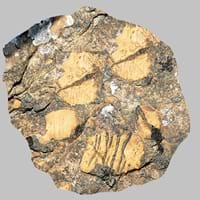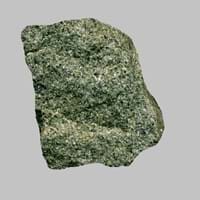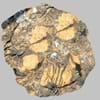Definition
Diamictite is a sedimentary rock that consists of non-sorted to poorly sorted terrigenous sediment containing particles that range in size from clay to boulders, suspended in a matrix of mudstone or sandstone
Greywacke is defined as a dark coarse-grained sandstone rock which contains more than 15 per cent clay
Origin
Southern Mongolia
Unknown
Discoverer
Unknown
Unknown
Etymology
From Greek dia through and meiktós or mixed
From German Grauwacke, from grau grey + wacke
Class
Sedimentary Rocks
Sedimentary Rocks
Sub-Class
Durable Rock, Soft Rock
Durable Rock, Hard Rock
Group
Not Applicable
Not Applicable
Other Categories
Coarse Grained Rock, Opaque Rock
Fine Grained Rock, Opaque Rock
Color
Brown, Buff
Beige, Black, Brown, Colourless, Cream, Dark Brown, Green, Grey, Light Green, Light to Dark Grey, Pink, Red, White, Yellow
Durability
Durable
Durable
Interior Uses
Decorative Aggregates, Interior Decoration
Decorative Aggregates, Floor Tiles, Flooring, Homes, Interior Decoration
Exterior Uses
As Building Stone, Paving Stone
As Building Stone, As Facing Stone, Garden Decoration, Office Buildings, Paving Stone
Other Architectural Uses
Curbing
Curbing, Whetstones
Construction Industry
As Dimension Stone, Construction Aggregate, for Road Aggregate, Landscaping, Roadstone
Building houses or walls, Cement Manufacture, Construction Aggregate, for Road Aggregate, Raw material for the manufacture of mortar
Medical Industry
Not Yet Used
Not Yet Used
Antiquity Uses
Artifacts
Artifacts, Sculpture, Small Figurines
Commercial Uses
Commemorative Tablets, Creating Artwork, Production of Lime
As armour rock for sea walls, Petroleum reservoirs, Sea Defence, Tombstones
Types
Bedded Diamictite and Laminated Diamictite
Not Available
Features
Host Rock for Lead, Is one of the oldest rock
Available in Lots of Colors and Patterns, Generally rough to touch, Non-vesicular, Veined
Archaeological Significance
Monuments
Not Yet Used
Not Yet Used
Famous Monuments
Not Applicable
Not Applicable
Sculpture
Not Yet Used
Used
Famous Sculptures
Not Applicable
Data Not Available
Pictographs
Used
Not Used
Petroglyphs
Used
Not Used
Figurines
Not Yet Used
Used
Formation
Diamictite is unevenly sorted terrigenous, non-calcareous sedimentary rock which forms due to weathering of mudstone and sandstone.
Graywacke rock is a type of sedimentary rock, which is also known as immature sandstone, which is indurated, dark grey and consisting of poorly sorted angular to sub-angular, sand-sized grains.
Mineral Content
Calcite, Clay, Feldspar, Micas, Quartz
Augite, Biotite, Calcite, Chlorite, Clay, Clay Minerals, Feldspar, Micas, Muscovite or Illite, Plagioclase, Pyroxene, Quartz
Compound Content
Not Available
Aluminium Oxide, NaCl, CaO, Chromium(III) Oxide, Iron(III) Oxide, FeO, Potassium Oxide, Magnesium Carbonate, MgO, MnO, Sodium Oxide, Phosphorus Pentoxide, Silicon Dioxide, Titanium Dioxide
Types of Metamorphism
Not Applicable
Not Applicable
Types of Weathering
Biological Weathering, Chemical Weathering
Biological Weathering, Chemical Weathering
Types of Erosion
Chemical Erosion, Coastal Erosion, Water Erosion
Coastal Erosion, Sea Erosion, Wind Erosion
Grain Size
Coarse Grained
Angular and Fine
Fracture
Conchoidal to Uneven
Conchoidal
Streak
Light to dark brown
White
Porosity
Highly Porous
Highly Porous
Luster
Grainy, Pearly and Vitreous
Dull
Cleavage
Not Available
Perfect
Toughness
Not Available
2.6
Specific Gravity
4.3-5.0
2.2-2.8
Transparency
Opaque
Opaque
Density
2.2-2.35 g/cm3
2.6-2.61 g/cm3
Specific Heat Capacity
Not Available
Resistance
Heat Resistant, Impact Resistant
Heat Resistant, Impact Resistant, Pressure Resistant
Deposits in Eastern Continents
Asia
China, India, Kazakhstan, Mongolia, Russia
China, India, Kazakhstan, Mongolia, Russia, Uzbekistan
Africa
Namibia, Nigeria, South Africa
Namibia, Nigeria, South Africa
Europe
Austria, Denmark, Germany, Great Britain, Netherlands, Norway, Poland, Sweden, Switzerland, United Kingdom
Austria, Denmark, Germany, Great Britain, Netherlands, Norway, Poland, Sweden, Switzerland, United Kingdom
Others
Not Yet Found
Greenland
Deposits in Western Continents
North America
Canada, USA
Canada, USA
South America
Brazil, Venezuela
Brazil
Deposits in Oceania Continent
Australia
New South Wales, New Zealand
New South Wales, New Zealand
Diamictite vs Greywacke Characteristics
Though some rocks look identical, they have certain characteristics which distinguish them from others. Characteristics of rocks include texture, appearance, color, fracture, streak, hardness etc. Diamictite vs Greywacke characteristics assist us to distinguish and recognize rocks. Also you can check about Properties of Diamictite and Properties of Greywacke. Learn more about Diamictite vs Greywacke in the next section. The interior uses of Diamictite include Decorative aggregates and Interior decoration whereas the interior uses of Greywacke include Decorative aggregates, Floor tiles, Flooring, Homes and Interior decoration. Due to some exceptional properties of Diamictite and Greywacke, they have various applications in construction industry. The uses of Diamictite in construction industry include As dimension stone, Construction aggregate, For road aggregate, Landscaping, Roadstone and that of Greywacke include Building houses or walls, Cement manufacture, Construction aggregate, For road aggregate, Raw material for the manufacture of mortar.
More about Diamictite and Greywacke
Here you can know more about Diamictite and Greywacke. The life cycle of a rock consists of formation of rock, composition of rock and transformation of rock. The composition of Diamictite and Greywacke consists of mineral content and compound content. The mineral content of Diamictite includes Calcite, Clay, Feldspar, Micas, Quartz and mineral content of Greywacke includes Augite, Biotite, Calcite, Chlorite, Clay, Clay Minerals, Feldspar, Micas, Muscovite or Illite, Plagioclase, Pyroxene, Quartz. You can also check out the list of all Sedimentary Rocks. When we have to compare Diamictite vs Greywacke, the texture, color and appearance plays an important role in determining the type of rock. Diamictite is available in brown, buff colors whereas, Greywacke is available in beige, black, brown, colourless, cream, dark brown, green, grey, light green, light to dark grey, pink, red, white, yellow colors. Appearance of Diamictite is Banded and that of Greywacke is Dull. Properties of rock is another aspect for Diamictite vs Greywacke. The hardness of Diamictite is 2-3 and that of Greywacke is 6-7. The types of Diamictite are Bedded Diamictite and Laminated Diamictite whereas types of Greywacke are Not Available. Streak of rock is the color of powder produced when it is dragged across an unweathered surface. The streak of Diamictite is light to dark brown while that of Greywacke is white. The specific heat capacity of Diamictite is 0.75 kJ/Kg K and that of Greywacke is Not Available. Depending on the properties like hardness, toughness, specific heat capacity, porosity etc., rocks are resistant to heat, wear, impact, etc.Diamictite is heat resistant, impact resistant whereas Greywacke is heat resistant, impact resistant, pressure resistant.





